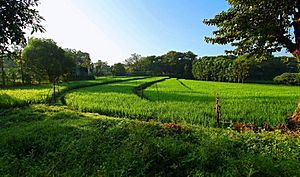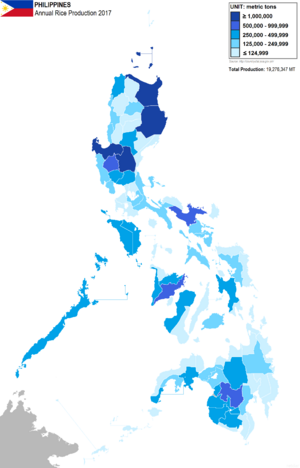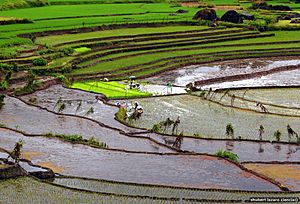Rice production in the Philippines facts for kids

Rice is super important in the Philippines! It's a main food source for many people and a big part of the country's economy. The Philippines is one of the world's top rice producers, ranking 8th globally. This means they grow a lot of rice, but sometimes they also need to buy rice from other countries to make sure everyone has enough to eat.
Contents
Where is Rice Grown in the Philippines?
Rice is the most important food crop and a staple food across most of the Philippines. It's grown widely in several key areas. These include Luzon, which is the largest island, the Western Visayas region, and both Southern and Central Mindanao. These regions have the right conditions for growing lots of rice.
How Much Rice Does the Philippines Produce?
In 2010, the Philippines produced almost 20.7 million metric tons of palay, which is rice before its outer husk is removed. This huge amount of rice made up a big part of the country's farming economy. By 2017, the Philippines was growing about 93% of the rice it needed each year. People in the country ate about 11.7 million tons of rice that year.
A Look at Rice Farming History
For a long time, the amount of rice grown per area of land in the Philippines was lower compared to other countries in Asia. But things started to change!
What Was the Green Revolution?
Since the mid-1980s, rice farms in the Philippines have become much more productive. This happened because of something called the Green Revolution. During this time, new types of rice plants were developed at the International Rice Research Institute (IRRI), which is located right in the Philippines. These new rice varieties could produce much more grain.
Because of these "miracle" rice types, the amount of rice grown per hectare (a unit of land) increased a lot. For example, in 1961, farmers grew about 1.23 metric tons per hectare. By 2009, this had jumped to 3.59 metric tons per hectare!
The Green Revolution also meant farmers started using more chemicals, like insecticides, to protect their crops. However, over time, the use of these chemicals has gone down, and it's now even lower than before the Green Revolution began.
How Did Irrigation Help Rice Farming?
The government also worked hard to build more irrigation systems. Irrigation helps bring water to rice fields, which is very important for growing healthy rice. The area of land that could be irrigated grew from less than 500,000 hectares in the mid-1960s to 1.5 million hectares by 2009. This means almost half of the land suitable for irrigation was being used.
In the 1980s, rice production faced some challenges. There were tropical storms and droughts, and the country's economy was not doing well. This made it harder for farmers to get loans and buy what they needed. As a result, the Philippines had to import (buy from other countries) a lot of rice in 1985. Things got better in the late 1980s, but a severe drought in 1990 again led to more rice imports.
As of 2018, the Philippines had a special agreement with the World Trade Organization (WTO). This agreement allowed them to limit how much rice private companies could import. This was done to help protect local farmers and make sure their rice could be sold.
What About Genetically Modified Rice?
The government has also supported the use of genetically modified rice. This includes a special type called Golden rice. Golden rice is designed to have more Vitamin A, which can help improve people's health.



